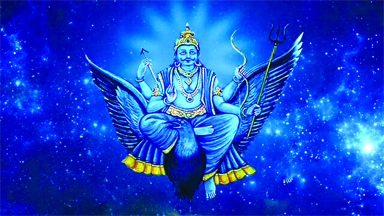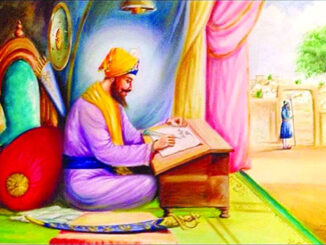
Shani Jayanti, also known as Shanishchara Jayanti, marks the birth anniversary of Lord Shani (Saturn), one of the most revered and feared deities in Hindu astrology and mythology. It is a day of immense spiritual significance, especially for devotees seeking relief from malefic planetary influences. Lord Shani is regarded as the stern dispenser of justice, karma, and discipline. His influence is often associated with trials and tribulations, but also with deep spiritual growth and liberation through perseverance and righteousness.
Etymology and Meaning
– Shani: The word “Shani” comes from the root “Shanaye Kramati Sa?”, which means “the one who moves slowly”. True to his name, the planet Saturn takes around 30 years to complete one orbit around the Sun, the slowest among the Navagrahas (nine celestial influences).
– Jayanti: A Sanskrit term meaning “birth anniversary” or “celebration of birth”.
Thus, Shani Jayanti is the celebration of the birth of the slow-moving planetary deity, Lord Shani.
Birth of Lord Shani
According to Skanda Purana and Bhavishya Purana, Lord Shani is the son of Surya Dev (Sun God) and Chhaya, the shadow form of Surya’s consort Sanjana. When Sanjana could no longer bear the intense radiance of Surya, she created her shadow duplicate Chhaya to serve her husband and retreated into penance. In time, Chhaya gave birth to Shani.
Shani’s birth was accompanied by several omens-his complexion was dark, his gaze austere, and his presence invoked fear even among gods. It is said that when Shani first opened his eyes as a newborn, Surya’s chariot horses staggered, and the sun’s brilliance dimmed-a symbolic indication of his powerful gaze.
Rituals and Observances
Shani Jayanti is considered a particularly favorable time for performing Shani Shanti puja, dosha nivaran rituals, and acts of charity, all aimed at pacifying the potentially challenging effects of Saturn’s transit, especially during periods like Sade Sati and Shani Dhaiya.
Early Morning Devotion
Devotees wake up during the Brahma Muhurat and take a ritual bath, after which they dress in black or dark blue garments, the colors associated with Shani. Worship begins with the Abhishekam (ritual bathing) of Shani idols using:
– Mustard oil
– Black sesame seeds
– Panchamrit (a mixture of milk, curd, honey, ghee, and sugar)
– Water and sandalwood paste
Relation of shani dev with other planets
Shani Dev is considered to be the lord of Capricorn and Aquarius. Mercury and Venus are considered friends of Shani Dev while Sun, Moon and Mars are considered as their enemies. At the same time, their relation with the Guru is of equanimity.
Saturn in astrology
Saturn is said to be the best among the Navagrahas, because it stays on one zodiac for the longest time. Saturn stays in one sign for two and a half years. No other planetary sign lasts so long. Sun, Moon, Mars are considered enemies of Saturn while Mercury and Venus are friendly planets. Jupiter is even planet.
Saturn sitting in the Ascendant is not good and gives trouble to the native. If we talk about numerology, then the number 8 is considered to be of Saturn. If the sum of the digits of the date of birth of any person is 8, then its numeral will be Shani Dev. If the person is born on 8th, 17th, 26th, then the Ankadhipati is Shani Dev. In such a situation, it becomes important for the person to get his grace by pleasing them.
How to please Shani Dev
Black clothes, jamun fruits, urad dal, black shoes and black things should be donated to avoid the angry vision of Shani Dev. Shani Darshan on every Saturday also has significance. By donating, Shani Dev is pleased and gives grace. The grace of Shani Dev can also be obtained by worshiping Hanumanji. Even before donating, taking advice of astrologers can be more fruitful and gives relief from sufferings.
Major Celebrations
Shani Shingnapur (Maharashtra)
The most prominent celebration takes place at the Shani Shingnapur Temple in Ahmednagar, Maharashtra. Known for its tradition of doorless homes symbolizing trust in divine justice, the village attracts thousands of devotees who perform mass oil abhishekam and take vows to lead honest, humble lives.
Thirunallar Shani Temple (Tamil Nadu)
In southern India, Thirunallar in Karaikal witnesses large gatherings of pilgrims who take a dip in the Nala Theertham, a sacred tank believed to cleanse Saturn-related afflictions.
Kokilavan Dham (Uttar Pradesh)
Located near Mathura, this temple is visited by thousands who believe that Lord Krishna pacified Shani Dev here. Special homams and prayers are conducted throughout the day.
Astrological Relevance
Astrologically, Shani is associated with structure, discipline, longevity, trials, and wisdom earned through hardship. His transit brings lessons that are often difficult but ultimately transformative. Saturn rules over:
– Capricorn and Aquarius
– Saturday (Shanivar)
– The nakshatras Pushya, Anuradha, and Uttara Bhadrapada
Devotees observing Shani Jayanti believe that worship on this day mitigates the effects of ongoing planetary doshas and opens the path to peace, prosperity, and spiritual evolution.
The Symbolism of Shani
Shani is both feared and revered. His gaze is believed to be so intense that even gods avoid it. Yet, his role in Hindu cosmology is crucial. He ensures that no deed goes unnoticed and no sin unpunished, emphasizing the cosmic law of cause and effect. His difficult influence is ultimately purifying-it breaks ego, tests faith, and reveals inner strength. A popular legend recounts that Lord Hanuman once rescued Shani Dev from the clutches of Ravana, earning his undying gratitude. Since then, it is believed that true devotees of Hanuman are protected from Saturn’s harsher effects.





Be the first to comment